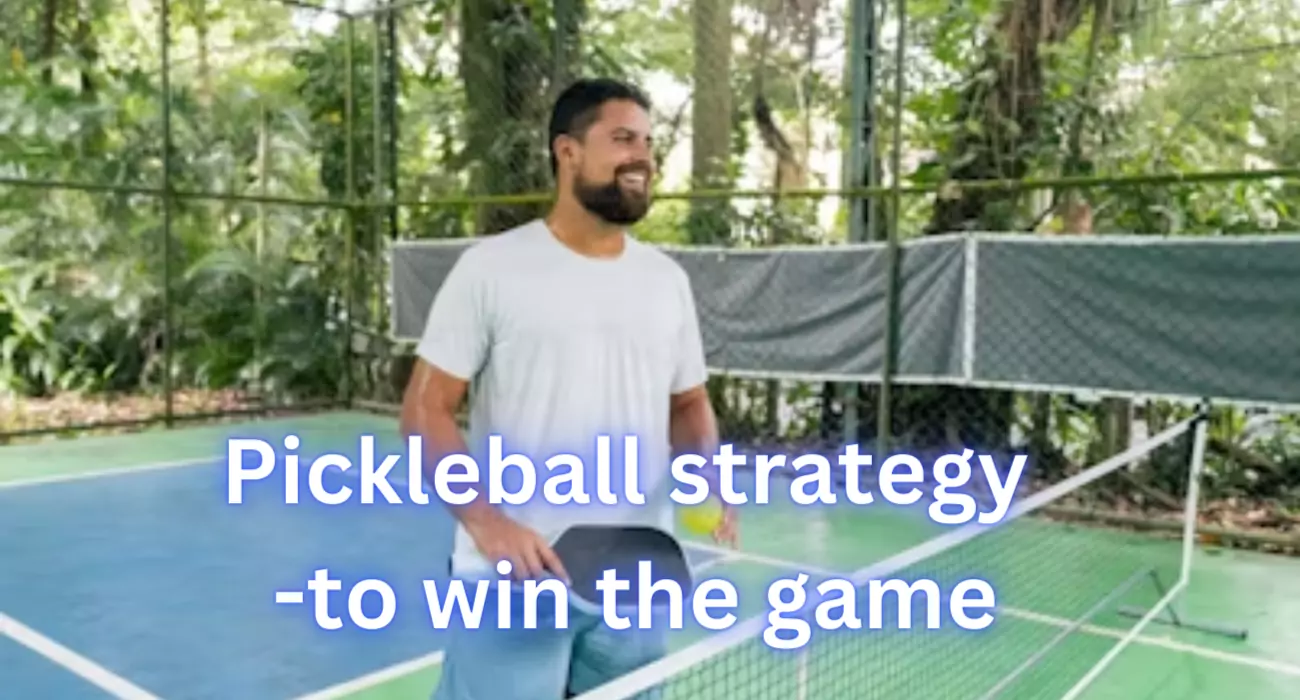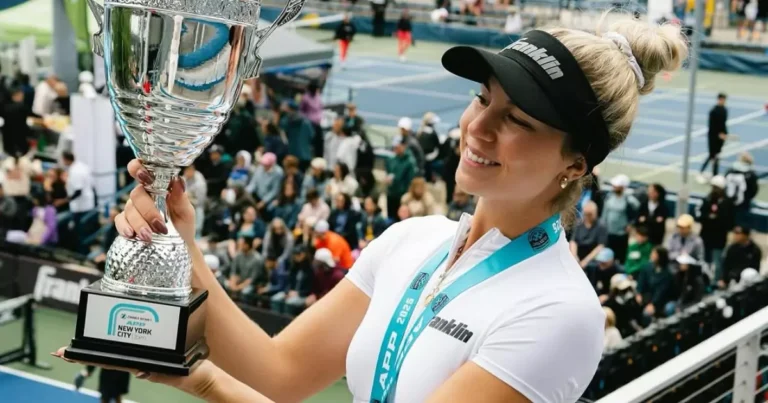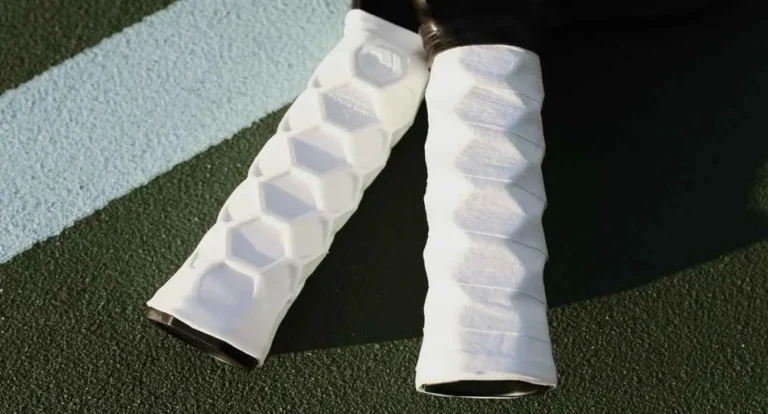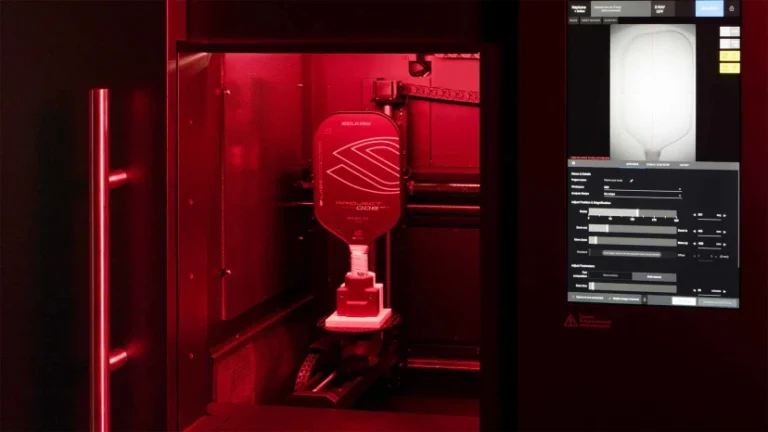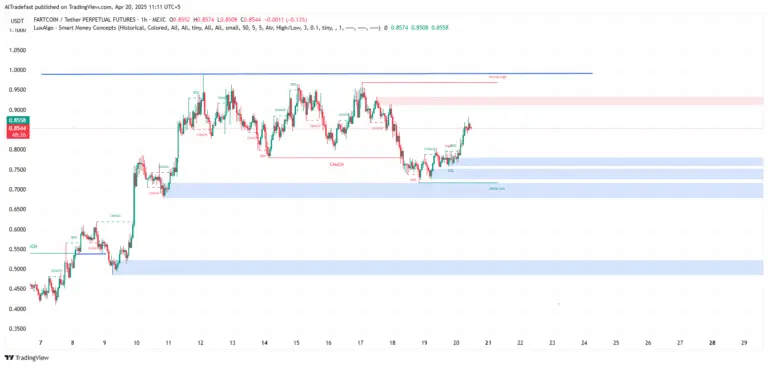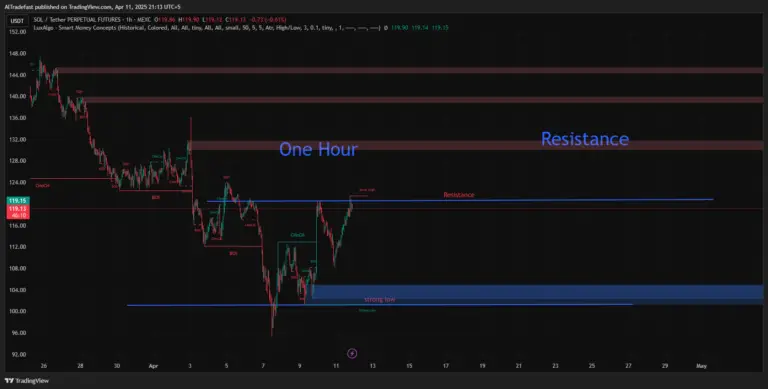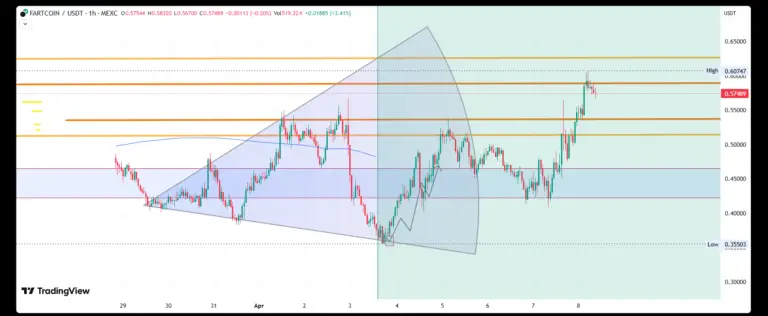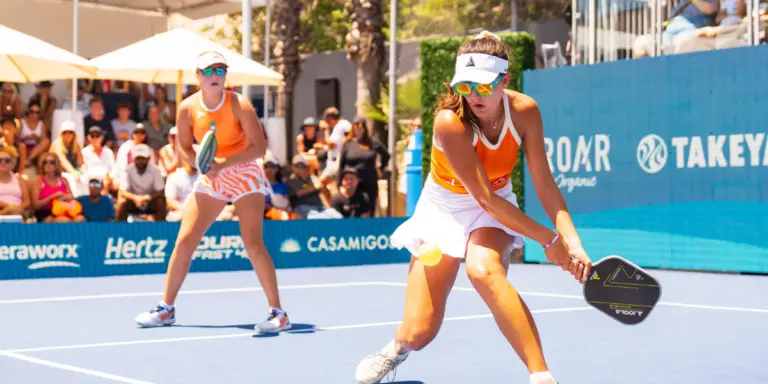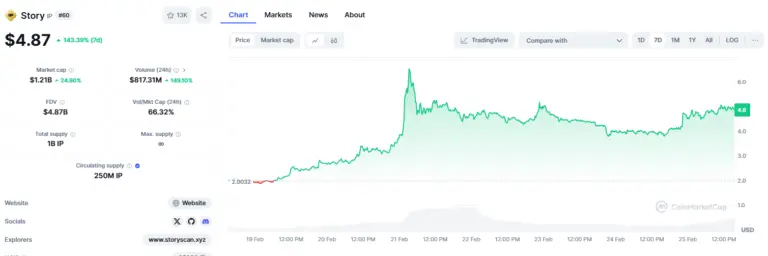As a beginner, mastering the basics of pickleball is just the starting point. To become a top player, you must develop effective strategies and techniques. Here’s how to level up your game and become a 5.0 pickleball player; building a solid foundation by developing good habits from the start is essential. Refine your skills by learning time-tested strategies and techniques, and avoid common pitfalls by steering clear of mistakes that hold you back.
In this article, we’ll share proven strategies to win more games, explain why strategy is critical in pickleball, and highlight common mistakes to avoid. Let’s dive in and take your game to the next level!
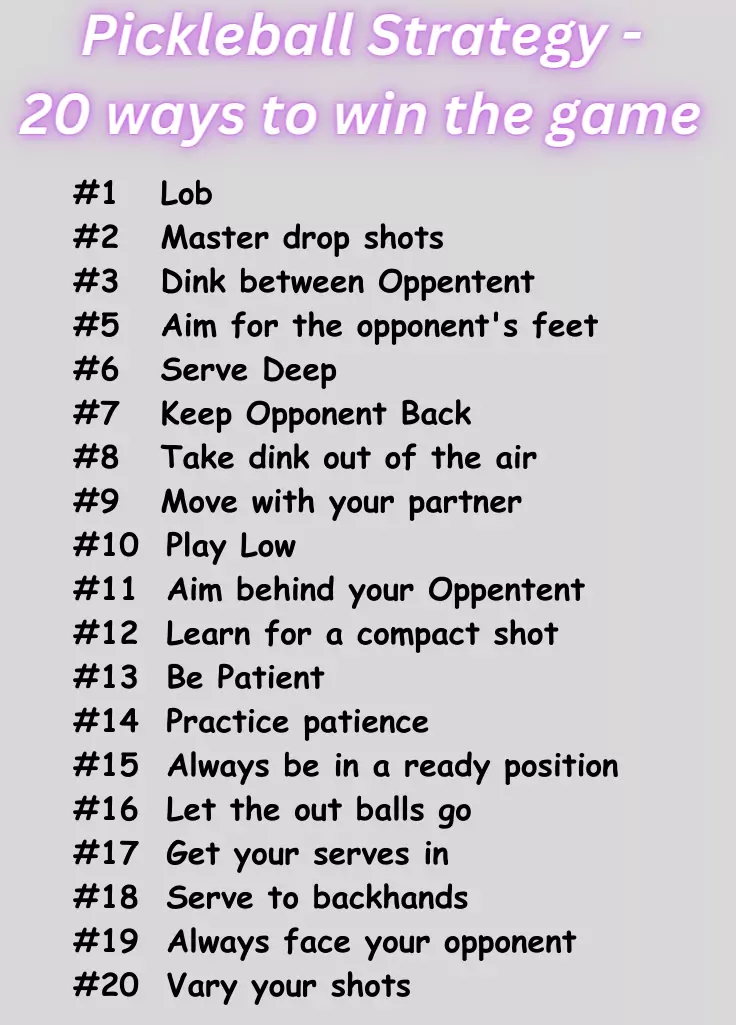
1. Lob-Carefully
The lob is a high-arcing shot that can be a valuable addition to your pickleball arsenal. When executed effectively, a lob can disrupt your opponent’s rhythm and force them to move off the non-volley zone (NVZ) line, also known as the “kitchen.” This can be particularly useful when your opponents are positioned near the net, as it can create an opportunity for you to gain an advantage.
Defensive Benefits
Defensively, the lob can provide you with valuable time to move and reposition while the ball is in the air. This can be especially helpful when facing an aggressive opponent who is applying pressure at the net on you.
Risks and Variations
However, it’s important to note that the lob is not without risk. If not executed properly, it can leave you open to an aggressive return shot from your opponent. Mixing up your shots and incorporating other techniques, such as drives, drop shots, and dinks, into your game is essential to mitigate this risk. By varying your shots and keeping your opponents guessing, you can increase your chances of success and become a more effective pickleball player.
2: Master the Third-Shot Drop: A Pickleball Strategy
The third-shot drop is a powerful tactic in pickleball, allowing you to gain control and create opportunities to win points. Here’s how to execute it effectively:
- Hit a soft, high-arcing shot: From deep in the court, hit a gentle, high-bouncing shot that lands in your opponent’s non-volley zone (NVZ).
- Aim for the NVZ: Make sure the shot lands in the NVZ, making it difficult for your opponent to attack.
- Gain an advantage: The third-shot drop gives you time to move forward and position yourself at the NVZ line while your opponent struggles to return the shot.
- Aim for the backhand: Target your opponent’s backhand side to make the return even more challenging.
3. Dink down between your opponents
The Art of the Dink: A Pickleball Strategy: A dink is a precise pickleball shot to exploit weaknesses in your opponents’ positioning. Here’s how to execute an effective dink:
- Hit after the bounce: Strike the ball after it has bounced in the non-volley zone (NVZ).
- Aim for the opponent’s NVZ: Target the opponent’s NVZ, aiming for a shot that arcs just above the net and lands softly in the NVZ.
- Split your opponents: If you dink between them, they may move towards the middle of the court, exposing weaknesses on their sides.
By mastering the dink, you can:
- Keep the ball low: Prevent your opponents from attacking the ball with power.
- Create opportunities: Expose weaknesses on your opponents’ sides, making it easier to score points.

4. Aim for your opponent’s feet
A Clever Pickleball Strategy: Targeting your opponent’s feet with your shot can be a clever tactic in pickleball, offering two significant advantages:
Advantage 1: Disrupting Footwork
A shot aimed at your opponent’s feet forces them to move quickly and adjust their position, making it challenging to maintain balance and control while returning the shot. This can lead to a weaker return, giving you an upper hand.
Advantage 2: Forcing an Underhand Return
If your opponent manages to return the shot, they’ll likely need to use an underhand stroke, which can result in a high-bouncing ball. This sets you up for a powerful follow-up shot, allowing you to take control of the point and potentially finish with a winning shot.
You can gain a strategic edge by aiming at your opponent’s feet and creating opportunities to dominate the court. Remember to use this tactic judiciously, combining it with other shots and strategies to keep your opponents guessing and off balance.
5. Add depth to your serve
Take your serving game to the next level by adding more power and depth! Aiming deep into your opponent’s service court can give you a significant advantage. Here’s how:
- Keep opponents back: A deep serve forces your opponents to start farther back in the court, giving you more time to get into position and control the point.
- Longer return time: A deep serve takes longer to return, allowing you to gain an edge in reaction time and positioning.
- Increased pressure: A powerful, deep serve can pressure your opponents, making them more likely to make errors or return a weak shot.
By adding more power and depth to your serve, you can:
- Take control of the point: A deep serve can give you the upper hand, allowing you to dictate the pace and direction of the rally.
- Create opportunities: A deep serve can set you up for a strong attack, making scoring points and dominating the game easier.
Remember, a powerful serve is just the starting point. Combine it with strategic positioning, clever shot placement, and quick reflexes to outmaneuver your opponents and win the game!

6. Keep opponents away from the kitchen line
The kitchen line is a crucial area in pickleball, offering prime scoring opportunities. To keep your opponents from exploiting this zone, use this effective tactic:
Keep Them Back and Moving
- Target the back player: Consistently hit shots to the player positioned at the back of the court, forcing them to stay away from the kitchen line.
- Side-to-side movement: Make your opponents move laterally, left and right, to return your shots. This will make it difficult for them to maintain a strong position and create scoring chances.
By keeping your opponents on their toes and away from the kitchen line, you’ll:
- Limit their scoring opportunities: Make it harder for them to capitalize on their chances.
- Create weaknesses: Force them to make errors or return weak shots, giving you an advantage.
- Gain control: Dominate the point and dictate the pace of the game.
Remember, controlling the kitchen line is crucial to success in pickleball. Use this strategy to keep your opponents at bay and claim the advantage!
7. Take more dinks out of the air
As a beginner, it’s common to develop the habit of letting dinks bounce before returning them. However, this can put you on the defensive and give your opponent the upper hand. To turn the tables, try volleying dinks before they can land!
The Power of Volleys:
- Disrupt opponent’s timing: Volleys can throw off your opponent’s rhythm and make it harder for them to anticipate your next move.
- Take control: By volleying dinks, you’re taking the initiative and putting pressure on your opponent.
- Create opportunities: Volleys can lead to weak returns or errors, giving you a chance to capitalize and score points.
Tips for Effective Volleys:
- Watch the ball closely: Keep your eyes on the ball and be prepared to react quickly.
- Use a soft touch: Aim for a gentle, controlled volley that lands in the opponent’s non-volley zone (NVZ).
- Practice, practice, practice: Develop your volley skills through practice and repetition.
Remember, volleying dink is a powerful tactic to help you gain an edge in pickleball. So, don’t be afraid to take control and turn the tide on your opponent!

8. Deep Returns: A Strategic Advantage in Pickleball
Consider using high-arcing deep returns to gain an upper hand when returning serves. This tactic offers two significant benefits:
Benefits of Deep Returns:
- Prevent opponent’s advancement: A deep return makes it challenging for your opponent to move forward and position themselves at the non-volley zone (NVZ) line, disrupting their usual strategy.
- Force a higher ball: By keeping your opponent farther back in the court, you’ll likely receive a higher-bouncing ball, which is easier to return and control.
Advantages of High-Arcing Deep Returns:
- More time to react: A high-arcing return gives you more time to react and position yourself for the next shot.
- Increased pressure: A deep return puts pressure on your opponent, making them more likely to make errors or return a weak shot.
- Better positioning: By keeping your opponent back, you can gain a strategic advantage in positioning, making it easier to control the point and score.
Remember, a well-executed deep return can turn the tables and give you the upper hand in a pickleball rally. So, aim high and deep to gain an edge over your opponents!
9. Move together with your partner
In doubles pickleball, teamwork and coordination are crucial to success. To dominate the court, focus on synchronizing your movements with your partner, maintaining a consistent distance apart, and flowing together like a well-oiled machine. When you move in harmony, you’ll:
- Cover each other’s weaknesses: By staying in sync, you’ll minimize exposed weaknesses and create a solid defensive wall.
- Create a united front: Coordinated movements confuse your opponents, making it harder for them to target individual weaknesses.
- Anticipate and react together: Moving as one allows you to anticipate and respond to shots more effectively, creating a formidable team defense.
Remember, gaps and weaknesses emerge when you fail to move together, inviting your opponents to exploit them. Stay in sync, and you’ll become an unstoppable doubles duo!
Tips for Synchronized Movements:
- Communicate: Call out shots and movements to ensure you’re on the same page.
- Watch each other’s backs: Be aware of your partner’s position and adjust your movements accordingly.
- Practice together: Develop your teamwork and coordination through practice and repetition.

10. Play low
Keep your shots low and precise as much as possible. A low-flying shot that clears the net is more challenging for your opponent to return, increasing their chances of responding with a high, defensive shot. You can gain a strategic advantage by keeping the ball low and pressuring your opponent’s defense.
11. Aim behind your opponent
Placing the ball behind your opponent is a strategic advantage, as it forces them to retreat and regroup, which can be challenging, especially if they’re caught off guard. This tactic can be achieved by using lobs, cross-court dinks, or well-placed low shots to the backhand side.
By making it difficult for your opponent to return the ball safely, you can disrupt their rhythm and limit their control over the shot. As a result, they’ll be more likely to hit low-percentage shots, giving you an upper hand in the rally. Additionally, this tactic can also create opportunities for you to take advantage of their weakened position and finish the point with a winning shot.
12. Learn a compact stroke
Efficiency is critical to dominating the court! A compact stroke technique maximizes speed and power while minimizing energy expenditure. By reducing both backswing and follow-through, you’ll be able to react faster and cover more ground.
Think of your follow-through as a gentle “toss” or “push” rather than a forceful “smack.” This mindset shift will help you generate power without wasting energy, allowing you to maintain a consistent and precise shot. By streamlining your stroke, you can outmaneuver your opponents quickly and precisely.

13. Be patient
Mainly, as you rise in skill, you’ll find that at its core, pickleball is a game about strategy and precision. Players won’t lose rallies by making simple, unforced errors often, and you’ll have to outplay them with patience and technique.
Focus on controlling the momentum of a rally and getting into position, and try to keep your opponents moving. Aim your shots toward different sides of your opponent and various court areas.
Conclusion
The most critical skill in pickleball combines physical and mental abilities, including hand-eye coordination and reaction time, footwork and court awareness, communication and teamwork (in doubles), strategic thinking and adaptability, and emotional control and focus.
Some tried-and-true strategies in pickleball include the “third shot drop,” a soft, angled shot that lands in the opponent’s backcourt, making it difficult for them to return. Another strategy is playing at the non-volley zone (NVZ) line, positioning yourself at the NVZ line to limit your opponent’s angles and create opportunities for winning shots.
In doubles, using the “I” formation, positioning the players in an “I” shape to cover the court and create confusion for the opponents, is also effective. Additionally, mixing up your shots and varying your shots, such as using soft and hard shots to keep your opponents guessing and off balance, playing to your opponent’s weakness, identifying your opponent’s weaker side or shot, and targeting it to gain an advantage are also vital strategies. Remember that pickleball is dynamic, and adapting to your opponents and the game’s flow is crucial.

